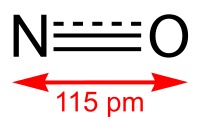
Photo from wikipedia
Inhaled nitric oxide (iNO) is a therapy used in neonates with pulmonary hypertension. Some evidence of its neuroprotective properties has been reported in both mature and immature brains subjected to… Click to show full abstract
Inhaled nitric oxide (iNO) is a therapy used in neonates with pulmonary hypertension. Some evidence of its neuroprotective properties has been reported in both mature and immature brains subjected to injury. NO is a key mediator of the VEGF pathway, and angiogenesis may be involved in the reduced vulnerability to injury of white matter and the cortex conferred by iNO. Here, we report the effect of iNO on angiogenesis in the developing brain and its potential effectors. We found that iNO promotes angiogenesis in the developing white matter and cortex during a critical window in P14 rat pups. This shift in the developmental program of brain angiogenesis was not related to a regulation of NO synthases by exogenous NO exposure, nor the VEGF pathway or other angiogenic factors. The effects of iNO on brain angiogenesis were found to be mimicked by circulating nitrate/nitrite, suggesting that these carriers may play a role in transporting NO to the brain. Finally, our data show that the soluble guanylate cyclase/cGMP signaling pathway is likely to be involved in the pro-angiogenetic effect of iNO through thrombospondin-1, a glycoprotein of the extracellular matrix, inhibiting soluble guanylate cyclase through CD42 and CD36. In conclusion, this study provides new insights into the biological basis of the effect of iNO in the developing brain.
Journal Title: International Journal of Molecular Sciences
Year Published: 2023
Link to full text (if available)
Share on Social Media: Sign Up to like & get
recommendations!